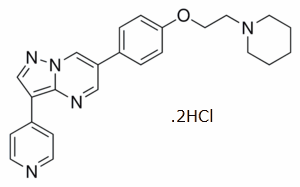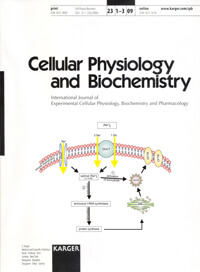All AbMole products are for research use only, cannot be used for human consumption.

Dorsomorphin (BML-275; Compound C) dihydrochloride is a potent inhibitor of AMP-activated protein kinase (AMPK) (Ki = 109 nM) and bone morphogenic protein (BMP) signaling. Dorsomorphin dihydrochloride inhibits AMPK activation induced by AICAR and metformin. Dorsomorphin dihydrochloride also inhibits the bone morphogenetic protein type 1 receptors ACTR-I (ALK2), BMPR-IA (ALK3), and BMPR-IB (ALK6). Dorsomorphin dihydrochloride induces autophagy in cancer cell lines via a mechanism independent of AMPK inhibition. Dorsomorphin dihydrochloride induces autophagy.

Patent. CN119367339A 2025-01-28.
Patent. CN119367339A
Dorsomorphin dihydrochloride purchased from AbMole

Biomed Pharmacother. 2024 May 23;176:116760.
Identification of a novel hypoglycemic small molecule, trans-2, 4-dimethoxystilbene by rectifying gut microbiota and activating hepatic AMPKα-PPARγ pathway through gut-liver axis
Dorsomorphin dihydrochloride purchased from AbMole

Int J Mol Sci. 2023 Jan 5;24(2):1070.
Sulforaphane Suppresses H2O2-Induced Oxidative Stress and Apoptosis via the Activation of AMPK/NFE2L2 Signaling Pathway in Goat Mammary Epithelial Cells
Dorsomorphin dihydrochloride purchased from AbMole

PLoS One. 2023 Dec 1;18(12):e0294566.
Silencing of topical proline hydroxylase domain 2 promotes the healing of rat diabetic wounds by phosphorylating AMPK
Dorsomorphin dihydrochloride purchased from AbMole

J Appl Toxicol. 2023 Feb 27.
AMP‐activated protein kinase‐farnesoid X receptor pathway contributes to oleanolic acid‐induced liver injury
Dorsomorphin dihydrochloride purchased from AbMole

Italian Journal of Food Science. 2023 Apr 17;35 (2): 13–21.
Pretreatment of kaempferol-3-O-rutinoside protects H9c2 cells against LPS-induced inflammation through the AMPK/SIRT1 pathway
Dorsomorphin dihydrochloride purchased from AbMole

Adv Sci (Weinh). 2022 Nov 22;10(1):e2204463.
Genetic and Pharmacological Inhibition of Astrocytic Mysm1 Alleviates Depressive-Like Disorders by Promoting ATP Production
Dorsomorphin dihydrochloride purchased from AbMole

Int J Biol Sci. 2022 Jan 31;18(4):1594-1611.
Atractylenolide III ameliorates Non-Alcoholic Fatty Liver Disease by activating Hepatic Adiponectin Receptor 1-Mediated AMPK Pathway
Dorsomorphin dihydrochloride purchased from AbMole

J Food Biochem. 2022 Aug 5;e14351.
Liquiritin inhibits H2O2-induced oxidative stress injury in H9c2 cells via the AMPK/SIRT1/NF-κB signaling pathway
Dorsomorphin dihydrochloride purchased from AbMole

Acta Histochem. 2022 Aug;124(6):151931.
Fibroblast-derived exosomal miRNA-133 promotes cardiomyocyte-like differentiation
Dorsomorphin dihydrochloride purchased from AbMole

Indian J Pharm Sci. 2022;2022:84(3)284-293.
Gallic acid Inhibits M1 Macrophage Polarization via Adenosine 5'-Monophosphate-Activated Protein Kinase/Signal Transducers and Activators of
Dorsomorphin dihydrochloride purchased from AbMole

Front Pharmacol. 2021 May 17;12:589273.
Dapagliflozin Alleviates Hepatic Steatosis by Restoring Autophagy via the AMPK-mTOR Pathway
Dorsomorphin dihydrochloride purchased from AbMole

J Cell Physiol. 2021 Mar;236(3):1889-1902.
Icariin ameliorates endothelial dysfunction in type 1 diabetic rats by suppressing ER stress via the PPARα/Sirt1/AMPKα pathway
Dorsomorphin dihydrochloride purchased from AbMole

Front Oncol. 2021 Jan 29;10:614067.
Solasonine Suppresses the Proliferation of Acute Monocytic Leukemia Through the Activation of the AMPK/FOXO3A Axis
Dorsomorphin dihydrochloride purchased from AbMole

BMC Cancer. 2021 Feb 25;21(1):195.
Blockage of AMPK-ULK1 pathway mediated autophagy promotes cell apoptosis to increase doxorubicin sensitivity in breast cancer (BC) cells: an in vitro study
Dorsomorphin dihydrochloride purchased from AbMole

Cell Physiol Biochem. 2018;50(6):2341-2364.
Peperomin E Induces Promoter Hypomethylation of Metastatic-Suppressor Genes and Attenuates Metastasis in Poorly Differentiated Gastric Cancer.
Dorsomorphin dihydrochloride purchased from AbMole
| Cell Experiment | |
|---|---|
| Cell lines | Spermatogonial Cell |
| Preparation method | Dorsomorphin was added to the medium at a final concentration of 0, 1, 2, 4, or 8 µM (in final 0.4% dimethyl sulfoxide). The cells were maintained at 28.5°C in an atmosphere of 3% carbon dioxide and the medium was replaced every 3–4 days. |
| Concentrations | 0, 1, 2, 4, or 8 µM |
| Incubation time | 3 weeks |
| Animal Experiment | |
|---|---|
| Animal models | C57BL/6 mice |
| Formulation | DMSO |
| Dosages | 10 mg/kg |
| Administration | i.p. |
| Molecular Weight | 472.41 |
| Formula | C24H25N5O.2HCl |
| CAS Number | 1219168-18-9 |
| Solubility (25°C) | Water 45 mg/mL DMSO 5 mg/mL (Need ultrasonic) |
| Storage |
Powder -20°C 3 years ; 4°C 2 years In solvent -80°C 6 months ; -20°C 1 month |
| Related AMPK Products |
|---|
| Aldometanib
Aldometanib (LXY-05-029) is an orally active aldolase inhibitor. |
| SAMS
SAMS peptide is a specific substrate for the AMP-activated protein kinase (AMPK). |
| Marein
Marein has the neuroprotective effect due to a reduction of damage to mitochondria function and activation of the AMPK signal pathway. |
| Malvidin-3-O-arabinoside chloride
Malvidin-3-O-arabinoside chloride ameliorates ethyl carbamate-induced oxidative damage by stimulating AMPK-mediated autophagy. |
| AMPK activator 12
AMPK activator 12 is a potent AMPK activator and GDF15 inducer. |
All AbMole products are for research use only, cannot be used for human consumption or veterinary use. We do not provide products or services to individuals. Please comply with the intended use and do not use AbMole products for any other purpose.


Products are for research use only. Not for human use. We do not sell to patients.
© Copyright 2010-2024 AbMole BioScience. All Rights Reserved.
